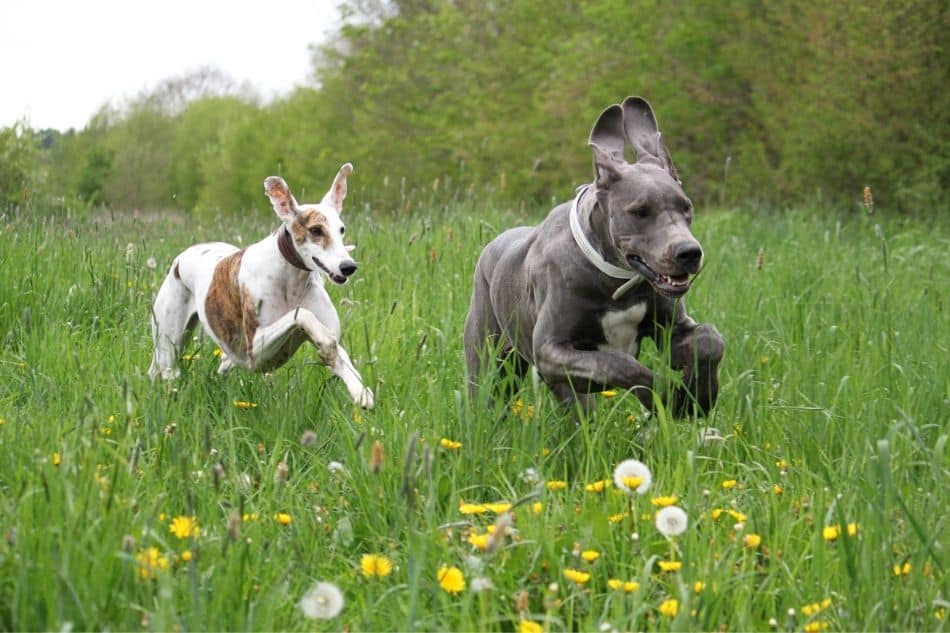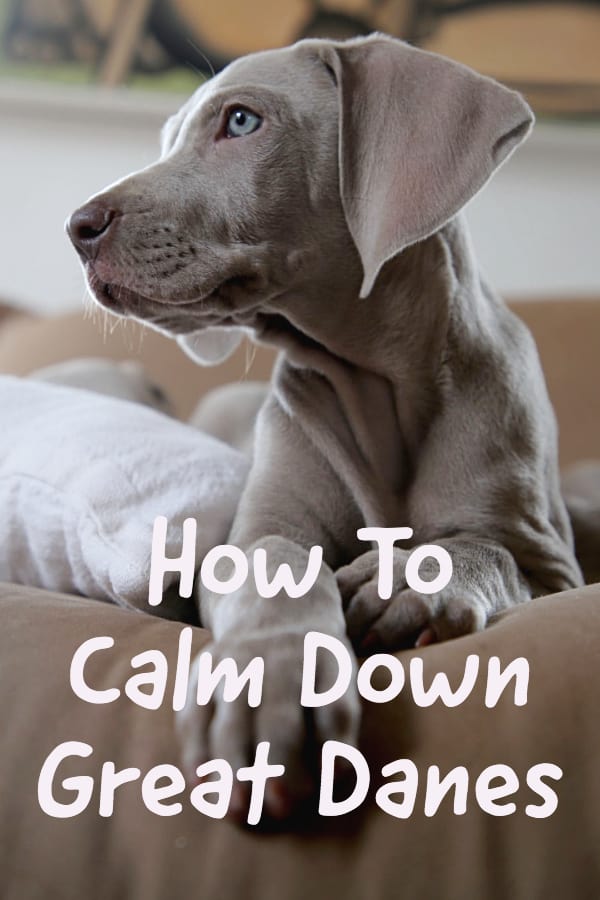
Uncover the age when Great Danes typically calm down, transitioning from playful pups to serene companions. This article guides you through the stages of a Great Dane’s life, highlighting when and how their energy levels change.
Great Dane puppies will have more energy than their adult counterparts. Most Great Danes lose this puppy energy around the age of two. However, a combination of training, exercise, and other tricks can be used to calm down a Great Dane of any age.
With that in mind, let’s take a deeper look at some of the practical tips to get your Great Dane to have a calmer demeanor.
Practical tips for getting your Great Dane to calm down
Tip #1 – Training (or lack thereof)
Not only will training your Great Dane pay massive dividends down the road, but it can greatly help with their general level of calmness.
Many people are quick to assume that any wild behavior from a dog is due to too much energy, but this isn’t always the case. It could also be due to anxiety or uncertainty about what to do.
By training them how to behave around the house as well as with the basic commands you will create a more confident dog. In the dog world, a confident dog is a calm one!
Think about it – how many times have you seen a well-trained go acting erratically? I’ll wait… 😉
Great Danes are quite literally giant people-pleasers – so not knowing what to do can literally drive them crazy!
Training covers a broad range of topics, and rather than give you short answers on each, I’ll simply provide links below to each one.
Tip #2 – Exercise
In addition to a solid training regimen, exercise is critical to having a calm Great Dane. Especially during their puppy years, excess energy usually gets put to bad use.
The saying “a tired puppy is a good puppy” holds true for dogs of all ages.
While dogs certainly get a fair amount of exercise during training, it’s also valuable to incorporate exercise in the form of play as well. Play is excellent at reducing stress, releasing pent-up energy, and bonding with your Great Dane.
Walks, playing fetch, and taking your Great Dane to the dog park are all excellent forms of playful exercise.
Once your dog is physically mature, you can also take them on hikes and runs. However, make sure to avoid highly strenuous activities e.g. forced running while they’re young to avoid orthopedic damage.
For more information about how to safely run with your Great Dane, take a look at our dedicated article here.
Tip #3 – Mental stimulation
Like physical exercise, mental stimulation is surprisingly effective at wearing out a Great Dane. It also has the benefit of keeping their attention while they try to solve a puzzle instead of letting a wandering mind turn to mischief!
Puzzle and interactive toys (link to one that we like on Amazon.com) are great ways to keep them mentally entertained while they try to figure out how to retrieve a treat or play the game.
If you do end up using toys that provide treats, make sure to keep a close eye on the added calories as you don’t want your dog to accidentally gain weight as a result.
Naturally, training sessions also double up as mental stimulation for your Great Dane. Younger dogs have a limited time that they can focus in training sessions, so make sure to keep them short and to the point.
As the dog gets older, you can slowly increase the training session duration.
A mixture of engaging toys and training sessions is usually the best mix here.
Tip #4 – Set a good example
The sayings “like father, like son” and “like mother, like daughter” imply that children often mirror their parents’ behaviors.
This holds true for dogs, especially Great Danes, who are highly sensitive to their owners’ emotions!
To foster a calm environment, approach your Great Dane with tranquility rather than anxiety or anger, which helps them learn to be more relaxed and prevents a tense atmosphere.
Tip #5 – Zoom Zoom!
Whether or not you like them, the zoomies are a classic Dane trait! I certainly don’t let our Great Dane run wild in the house, but if she does feel the occasional need for some zoomies then I won’t stop her from doing them outside.
These frantic zig-zag sprints usually only last a minute or two, and I’m fine to let her get them out of her system if that’s what she feels like she needs.
This is akin to nature’s way of releasing that little bit of pent-up energy or excitement, so in my opinion, it’s better to just let it happen!
These few minutes of excitement are typically followed by a long nap or calm period, so it certainly seems worthwhile to let nature run its course here 😉
Aside from not letting the zoomies occur indoors, I will also stop them from happening immediately after eating. While the data is still inconclusive, heavy exertion after eating has been long believed to be a factor in bloat.
Whether or not this is actually the case, it seems like a small price to pay to lessen the potential chances of bloat.
For more details about bloat, take a look at our dedicated article on the topic here.
Tip #6 – Patience is a virtue
Last but not least, the old saying “patience is a virtue” is absolutely true when it comes to calmness.
Putting breed aside, puppies have an overabundance of energy. While this will certainly test your patience, know that with time this extra energy will fade.
At what age do Great Danes settle down?
For most Great Danes, their puppy energy usually fades around the two-year mark.
This may happen a little sooner or later for some, but know that the puppy days don’t last forever! And I truly mean that for better or for worse 😉
This is longer than smaller breeds because Great Danes take longer to reach physical maturity. Their hormone remain elevated to support growth during this phase, and as such can contribute to higher energy or erratic behavior.
Are Great Danes high energy?
As a breed, Great Danes are moderate to low energy dogs.
Naturally, their energy will be higher during puppyhood, but most adult Great Danes have a very calm and relaxed demeanor, with relatively low energy. There are of course exceptions to this, but it seems to be the case for most Danes.
Unlike high-energy breeds such as Huskies, Border Collies, or Australian Shepherds, most Great Danes are content to just hang out with you! Given their large size, this shouldn’t come as a large surprise given how much energy they spend just moving around!
In fact, they’ll almost without a doubt spend more time asleep than awake on any given day. On average, Great Danes sleep 16-18 hours per day! If that doesn’t say low energy, I’m not sure what does 🙂
Casual walks or a play session each day is enough to meet the exercise needs of most adult Great Danes. Puppies will need more activity, however, assuming that you’re spending time training them every day that will account for a large portion of it.
Anxiety Related Issues
Even after addressing the tips mentioned above, it’s still possible that your dog’s poor behavior is anxiety-related.
Without context, it’s tough to say how every case of anxiety begins, but common sources include:
- Separation anxiety
- Environmental changes
- Home moves
- Loud noises
- Missing family members
Locating the source of your dog’s anxiety is the first step, and from there you can work to help address it. An anxious dog will have a very hard time being calm and collected, so work to address it instead of writing them off as “hyper” or otherwise.
For more information on this topic, you can find our article on addressing Great Dane anxiety here.


Gus is beautiful!